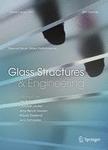版权所有:内蒙古大学图书馆 技术提供:维普资讯• 智图
内蒙古自治区呼和浩特市赛罕区大学西街235号 邮编: 010021

作者机构:Mondragon Unibertsitatea Loramendi Fluid Mech Arrasate Mondragon 20500 Spain Mondragon Unibertsitatea Struct Mech & Design Loramendi Arrasate Mondragon 20500 Spain
出 版 物:《GLASS STRUCTURES & ENGINEERING》 (Glass Struct. Eng.)
年 卷 期:2024年第9卷第3-4期
页 面:455-469页
核心收录:
基 金:ICME23 [KK-2023/00017, IT1505-22, IT1316] Basque Government
主 题:Glass tempering Risk of fracture Mist cooling Residual stresses Fluid-structure interaction
摘 要:In recent decades, there has been a perceptible transformation in how glass is perceived, evolving from being used for its aesthetic appeal to being acknowledged for its structural capabilities. Structural glass components are most often heat treated to increase their ultimate strength. For this purpose, the tempering process is applied. In this context, air is the quintessential cooling technique employed to rapidly cool and fortify the material due to its associated low cost. Nevertheless, it may encounter certain limitations when quenching low thickness components, making other techniques, such as spray mist cooling, to gain traction. Additionally, glass is a very brittle and sensitive material to local stress concentrations. Thus, depending on how the tempering process is performed, an excessive and/or non-homogeneous cooling might result in local transient stresses, which may exceed the allowable strength and cause premature fracture of the material. To this end, the non-uniform transient stress development during glass tempering is studied based on fluid-structure interaction modelling. In this way, the risk of in-process breakage considering the local phenomena during the glass cooling process is assessed. Water mist cooling is able to temper thin glass but, at the same time, large tensile stresses might develop during the cooling down process. This fact fosters the adoption of an interrupt tempering technique. The obtained numerical results are consistent with previous experimental investigations available in the literature.